Case Study: Managing Post-operative Ileus and Pulmonary Edema
VerifiedAdded on 2022/09/18
|10
|3026
|23
Case Study
AI Summary
This case study presents the case of an 82-year-old male patient who developed post-operative ileus and pulmonary edema following a colostomy surgery. The patient, with a medical history of diabetes, obesity, gout, and heart failure, experienced symptoms including vomiting, abdominal pain, and respiratory distress. The case study details the patient's medical history, symptoms, and physical examination findings, leading to a diagnosis of post-operative ileus and pulmonary edema. The study outlines nursing goals focused on managing these conditions, including administering intravenous fluids, nasogastric decompression, and anti-inflammatory drugs. Additionally, oxygen supplementation and infection prevention strategies are discussed. The case study also explores pharmacological interventions, such as opioid antagonists and NSAIDs, for managing the patient's condition, referencing relevant medical literature to support the treatment approaches.
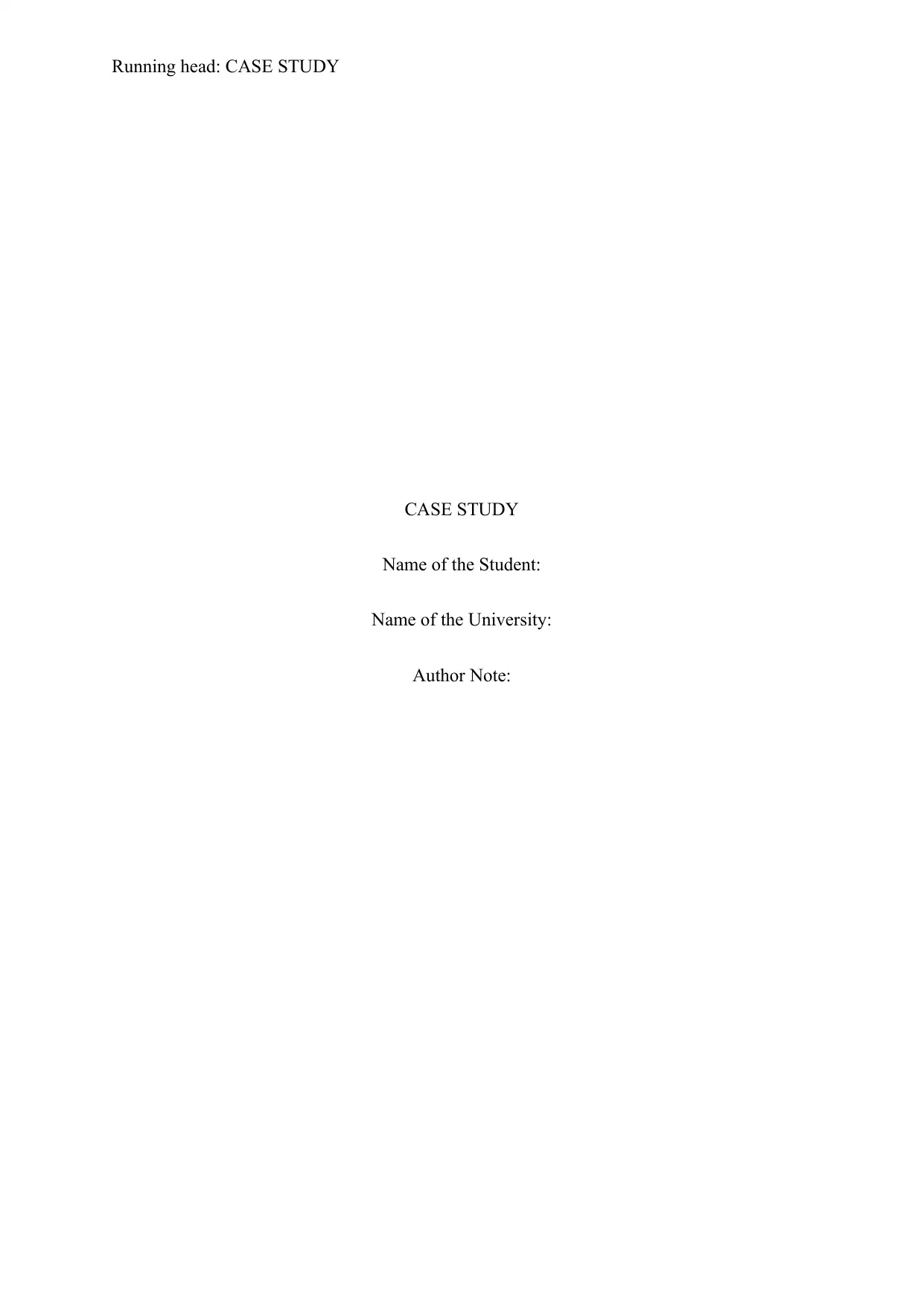
Running head: CASE STUDY
CASE STUDY
Name of the Student:
Name of the University:
Author Note:
CASE STUDY
Name of the Student:
Name of the University:
Author Note:
Paraphrase This Document
Need a fresh take? Get an instant paraphrase of this document with our AI Paraphraser
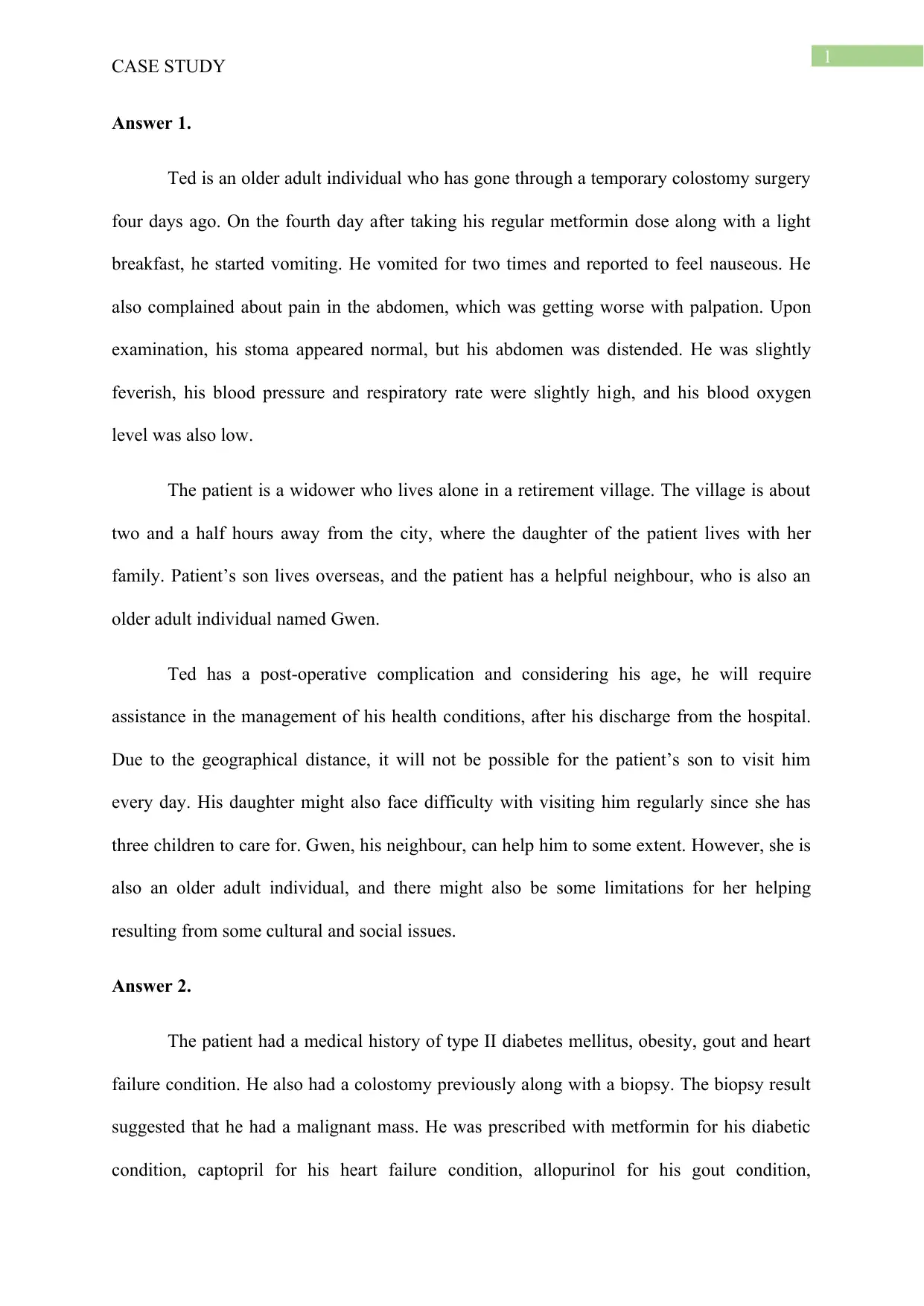
1
CASE STUDY
Answer 1.
Ted is an older adult individual who has gone through a temporary colostomy surgery
four days ago. On the fourth day after taking his regular metformin dose along with a light
breakfast, he started vomiting. He vomited for two times and reported to feel nauseous. He
also complained about pain in the abdomen, which was getting worse with palpation. Upon
examination, his stoma appeared normal, but his abdomen was distended. He was slightly
feverish, his blood pressure and respiratory rate were slightly high, and his blood oxygen
level was also low.
The patient is a widower who lives alone in a retirement village. The village is about
two and a half hours away from the city, where the daughter of the patient lives with her
family. Patient’s son lives overseas, and the patient has a helpful neighbour, who is also an
older adult individual named Gwen.
Ted has a post-operative complication and considering his age, he will require
assistance in the management of his health conditions, after his discharge from the hospital.
Due to the geographical distance, it will not be possible for the patient’s son to visit him
every day. His daughter might also face difficulty with visiting him regularly since she has
three children to care for. Gwen, his neighbour, can help him to some extent. However, she is
also an older adult individual, and there might also be some limitations for her helping
resulting from some cultural and social issues.
Answer 2.
The patient had a medical history of type II diabetes mellitus, obesity, gout and heart
failure condition. He also had a colostomy previously along with a biopsy. The biopsy result
suggested that he had a malignant mass. He was prescribed with metformin for his diabetic
condition, captopril for his heart failure condition, allopurinol for his gout condition,
CASE STUDY
Answer 1.
Ted is an older adult individual who has gone through a temporary colostomy surgery
four days ago. On the fourth day after taking his regular metformin dose along with a light
breakfast, he started vomiting. He vomited for two times and reported to feel nauseous. He
also complained about pain in the abdomen, which was getting worse with palpation. Upon
examination, his stoma appeared normal, but his abdomen was distended. He was slightly
feverish, his blood pressure and respiratory rate were slightly high, and his blood oxygen
level was also low.
The patient is a widower who lives alone in a retirement village. The village is about
two and a half hours away from the city, where the daughter of the patient lives with her
family. Patient’s son lives overseas, and the patient has a helpful neighbour, who is also an
older adult individual named Gwen.
Ted has a post-operative complication and considering his age, he will require
assistance in the management of his health conditions, after his discharge from the hospital.
Due to the geographical distance, it will not be possible for the patient’s son to visit him
every day. His daughter might also face difficulty with visiting him regularly since she has
three children to care for. Gwen, his neighbour, can help him to some extent. However, she is
also an older adult individual, and there might also be some limitations for her helping
resulting from some cultural and social issues.
Answer 2.
The patient had a medical history of type II diabetes mellitus, obesity, gout and heart
failure condition. He also had a colostomy previously along with a biopsy. The biopsy result
suggested that he had a malignant mass. He was prescribed with metformin for his diabetic
condition, captopril for his heart failure condition, allopurinol for his gout condition,
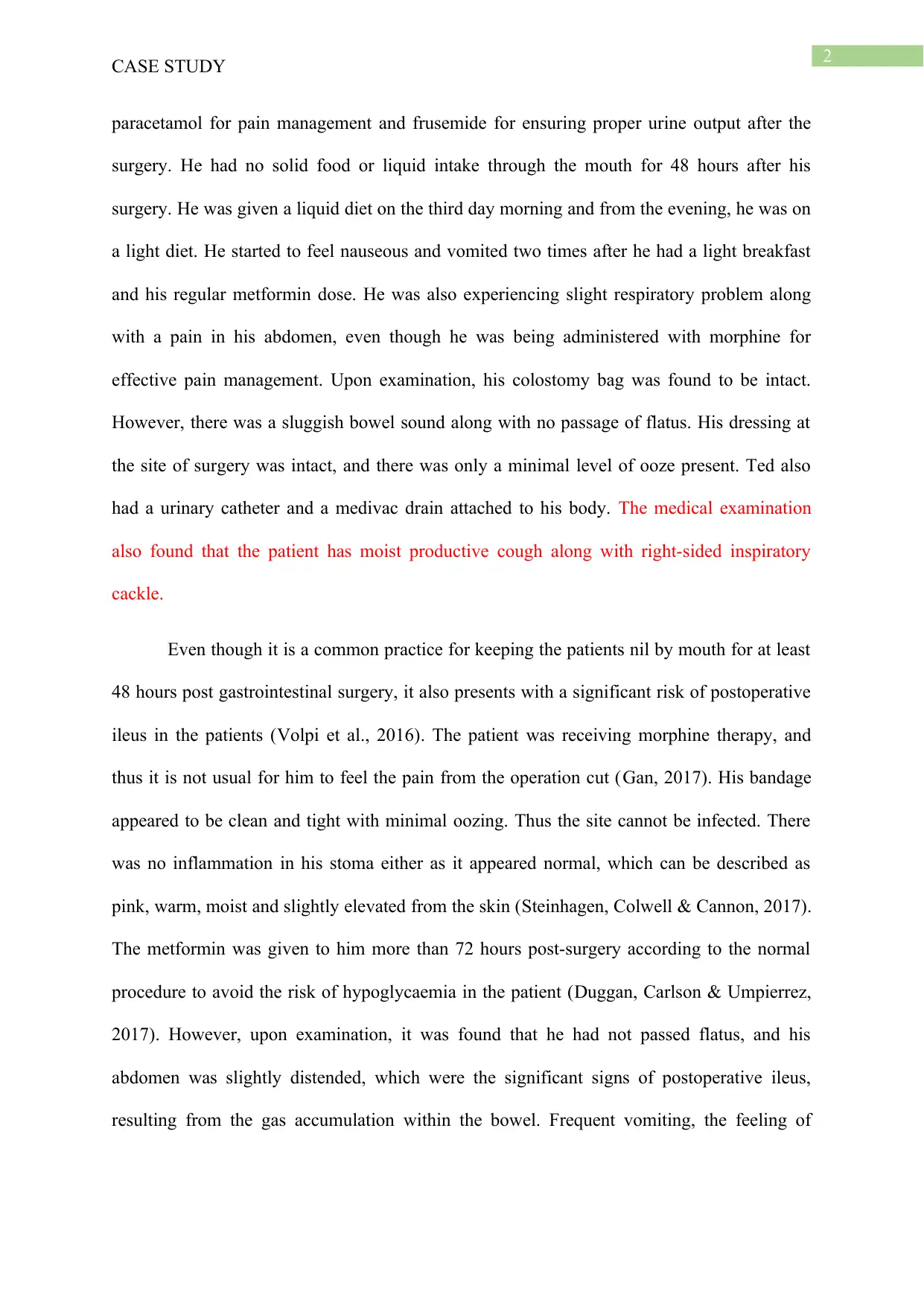
2
CASE STUDY
paracetamol for pain management and frusemide for ensuring proper urine output after the
surgery. He had no solid food or liquid intake through the mouth for 48 hours after his
surgery. He was given a liquid diet on the third day morning and from the evening, he was on
a light diet. He started to feel nauseous and vomited two times after he had a light breakfast
and his regular metformin dose. He was also experiencing slight respiratory problem along
with a pain in his abdomen, even though he was being administered with morphine for
effective pain management. Upon examination, his colostomy bag was found to be intact.
However, there was a sluggish bowel sound along with no passage of flatus. His dressing at
the site of surgery was intact, and there was only a minimal level of ooze present. Ted also
had a urinary catheter and a medivac drain attached to his body. The medical examination
also found that the patient has moist productive cough along with right-sided inspiratory
cackle.
Even though it is a common practice for keeping the patients nil by mouth for at least
48 hours post gastrointestinal surgery, it also presents with a significant risk of postoperative
ileus in the patients (Volpi et al., 2016). The patient was receiving morphine therapy, and
thus it is not usual for him to feel the pain from the operation cut (Gan, 2017). His bandage
appeared to be clean and tight with minimal oozing. Thus the site cannot be infected. There
was no inflammation in his stoma either as it appeared normal, which can be described as
pink, warm, moist and slightly elevated from the skin (Steinhagen, Colwell & Cannon, 2017).
The metformin was given to him more than 72 hours post-surgery according to the normal
procedure to avoid the risk of hypoglycaemia in the patient (Duggan, Carlson & Umpierrez,
2017). However, upon examination, it was found that he had not passed flatus, and his
abdomen was slightly distended, which were the significant signs of postoperative ileus,
resulting from the gas accumulation within the bowel. Frequent vomiting, the feeling of
CASE STUDY
paracetamol for pain management and frusemide for ensuring proper urine output after the
surgery. He had no solid food or liquid intake through the mouth for 48 hours after his
surgery. He was given a liquid diet on the third day morning and from the evening, he was on
a light diet. He started to feel nauseous and vomited two times after he had a light breakfast
and his regular metformin dose. He was also experiencing slight respiratory problem along
with a pain in his abdomen, even though he was being administered with morphine for
effective pain management. Upon examination, his colostomy bag was found to be intact.
However, there was a sluggish bowel sound along with no passage of flatus. His dressing at
the site of surgery was intact, and there was only a minimal level of ooze present. Ted also
had a urinary catheter and a medivac drain attached to his body. The medical examination
also found that the patient has moist productive cough along with right-sided inspiratory
cackle.
Even though it is a common practice for keeping the patients nil by mouth for at least
48 hours post gastrointestinal surgery, it also presents with a significant risk of postoperative
ileus in the patients (Volpi et al., 2016). The patient was receiving morphine therapy, and
thus it is not usual for him to feel the pain from the operation cut (Gan, 2017). His bandage
appeared to be clean and tight with minimal oozing. Thus the site cannot be infected. There
was no inflammation in his stoma either as it appeared normal, which can be described as
pink, warm, moist and slightly elevated from the skin (Steinhagen, Colwell & Cannon, 2017).
The metformin was given to him more than 72 hours post-surgery according to the normal
procedure to avoid the risk of hypoglycaemia in the patient (Duggan, Carlson & Umpierrez,
2017). However, upon examination, it was found that he had not passed flatus, and his
abdomen was slightly distended, which were the significant signs of postoperative ileus,
resulting from the gas accumulation within the bowel. Frequent vomiting, the feeling of
⊘ This is a preview!⊘
Do you want full access?
Subscribe today to unlock all pages.

Trusted by 1+ million students worldwide
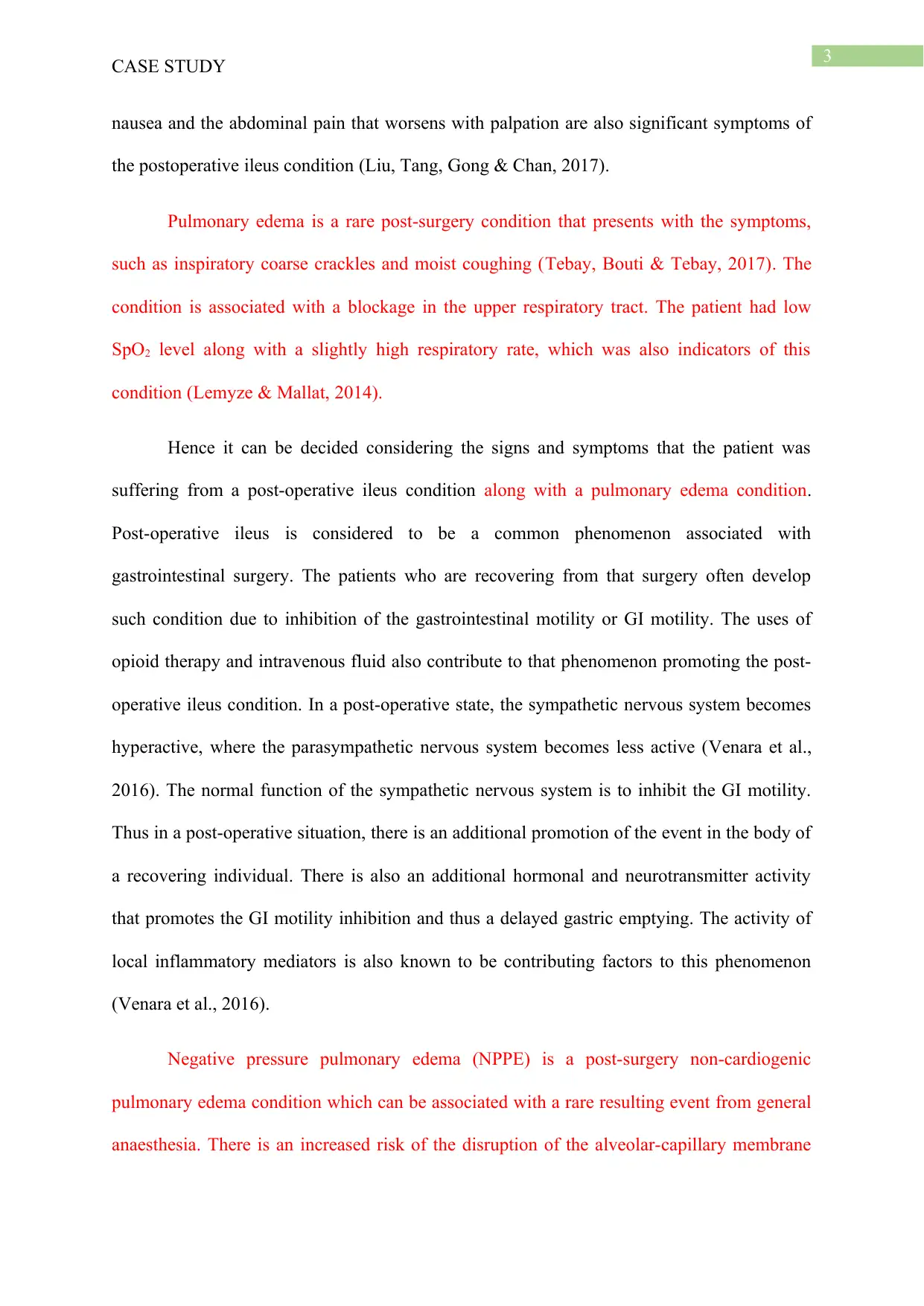
3
CASE STUDY
nausea and the abdominal pain that worsens with palpation are also significant symptoms of
the postoperative ileus condition (Liu, Tang, Gong & Chan, 2017).
Pulmonary edema is a rare post-surgery condition that presents with the symptoms,
such as inspiratory coarse crackles and moist coughing (Tebay, Bouti & Tebay, 2017). The
condition is associated with a blockage in the upper respiratory tract. The patient had low
SpO2 level along with a slightly high respiratory rate, which was also indicators of this
condition (Lemyze & Mallat, 2014).
Hence it can be decided considering the signs and symptoms that the patient was
suffering from a post-operative ileus condition along with a pulmonary edema condition.
Post-operative ileus is considered to be a common phenomenon associated with
gastrointestinal surgery. The patients who are recovering from that surgery often develop
such condition due to inhibition of the gastrointestinal motility or GI motility. The uses of
opioid therapy and intravenous fluid also contribute to that phenomenon promoting the post-
operative ileus condition. In a post-operative state, the sympathetic nervous system becomes
hyperactive, where the parasympathetic nervous system becomes less active (Venara et al.,
2016). The normal function of the sympathetic nervous system is to inhibit the GI motility.
Thus in a post-operative situation, there is an additional promotion of the event in the body of
a recovering individual. There is also an additional hormonal and neurotransmitter activity
that promotes the GI motility inhibition and thus a delayed gastric emptying. The activity of
local inflammatory mediators is also known to be contributing factors to this phenomenon
(Venara et al., 2016).
Negative pressure pulmonary edema (NPPE) is a post-surgery non-cardiogenic
pulmonary edema condition which can be associated with a rare resulting event from general
anaesthesia. There is an increased risk of the disruption of the alveolar-capillary membrane
CASE STUDY
nausea and the abdominal pain that worsens with palpation are also significant symptoms of
the postoperative ileus condition (Liu, Tang, Gong & Chan, 2017).
Pulmonary edema is a rare post-surgery condition that presents with the symptoms,
such as inspiratory coarse crackles and moist coughing (Tebay, Bouti & Tebay, 2017). The
condition is associated with a blockage in the upper respiratory tract. The patient had low
SpO2 level along with a slightly high respiratory rate, which was also indicators of this
condition (Lemyze & Mallat, 2014).
Hence it can be decided considering the signs and symptoms that the patient was
suffering from a post-operative ileus condition along with a pulmonary edema condition.
Post-operative ileus is considered to be a common phenomenon associated with
gastrointestinal surgery. The patients who are recovering from that surgery often develop
such condition due to inhibition of the gastrointestinal motility or GI motility. The uses of
opioid therapy and intravenous fluid also contribute to that phenomenon promoting the post-
operative ileus condition. In a post-operative state, the sympathetic nervous system becomes
hyperactive, where the parasympathetic nervous system becomes less active (Venara et al.,
2016). The normal function of the sympathetic nervous system is to inhibit the GI motility.
Thus in a post-operative situation, there is an additional promotion of the event in the body of
a recovering individual. There is also an additional hormonal and neurotransmitter activity
that promotes the GI motility inhibition and thus a delayed gastric emptying. The activity of
local inflammatory mediators is also known to be contributing factors to this phenomenon
(Venara et al., 2016).
Negative pressure pulmonary edema (NPPE) is a post-surgery non-cardiogenic
pulmonary edema condition which can be associated with a rare resulting event from general
anaesthesia. There is an increased risk of the disruption of the alveolar-capillary membrane
Paraphrase This Document
Need a fresh take? Get an instant paraphrase of this document with our AI Paraphraser
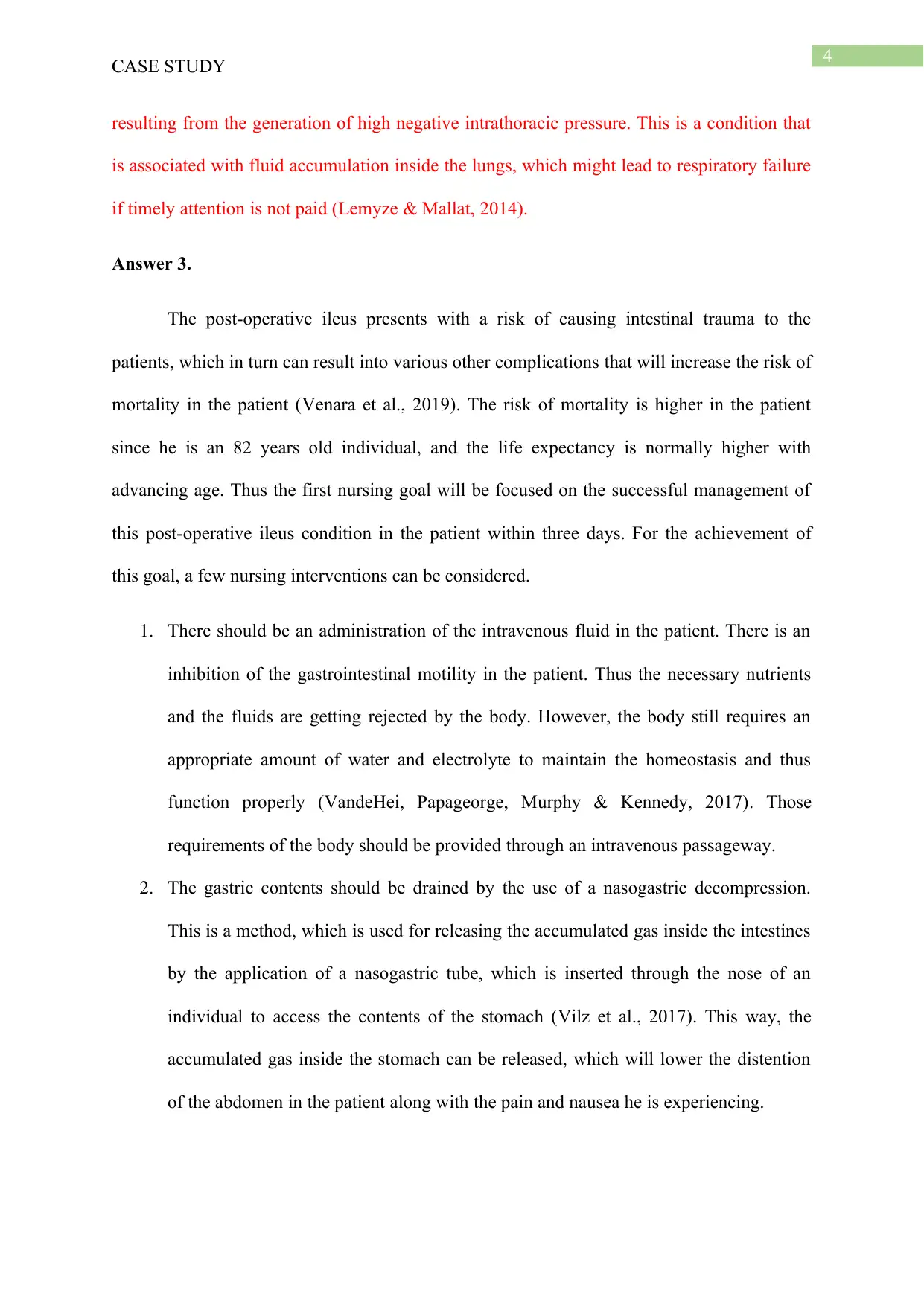
4
CASE STUDY
resulting from the generation of high negative intrathoracic pressure. This is a condition that
is associated with fluid accumulation inside the lungs, which might lead to respiratory failure
if timely attention is not paid (Lemyze & Mallat, 2014).
Answer 3.
The post-operative ileus presents with a risk of causing intestinal trauma to the
patients, which in turn can result into various other complications that will increase the risk of
mortality in the patient (Venara et al., 2019). The risk of mortality is higher in the patient
since he is an 82 years old individual, and the life expectancy is normally higher with
advancing age. Thus the first nursing goal will be focused on the successful management of
this post-operative ileus condition in the patient within three days. For the achievement of
this goal, a few nursing interventions can be considered.
1. There should be an administration of the intravenous fluid in the patient. There is an
inhibition of the gastrointestinal motility in the patient. Thus the necessary nutrients
and the fluids are getting rejected by the body. However, the body still requires an
appropriate amount of water and electrolyte to maintain the homeostasis and thus
function properly (VandeHei, Papageorge, Murphy & Kennedy, 2017). Those
requirements of the body should be provided through an intravenous passageway.
2. The gastric contents should be drained by the use of a nasogastric decompression.
This is a method, which is used for releasing the accumulated gas inside the intestines
by the application of a nasogastric tube, which is inserted through the nose of an
individual to access the contents of the stomach (Vilz et al., 2017). This way, the
accumulated gas inside the stomach can be released, which will lower the distention
of the abdomen in the patient along with the pain and nausea he is experiencing.
CASE STUDY
resulting from the generation of high negative intrathoracic pressure. This is a condition that
is associated with fluid accumulation inside the lungs, which might lead to respiratory failure
if timely attention is not paid (Lemyze & Mallat, 2014).
Answer 3.
The post-operative ileus presents with a risk of causing intestinal trauma to the
patients, which in turn can result into various other complications that will increase the risk of
mortality in the patient (Venara et al., 2019). The risk of mortality is higher in the patient
since he is an 82 years old individual, and the life expectancy is normally higher with
advancing age. Thus the first nursing goal will be focused on the successful management of
this post-operative ileus condition in the patient within three days. For the achievement of
this goal, a few nursing interventions can be considered.
1. There should be an administration of the intravenous fluid in the patient. There is an
inhibition of the gastrointestinal motility in the patient. Thus the necessary nutrients
and the fluids are getting rejected by the body. However, the body still requires an
appropriate amount of water and electrolyte to maintain the homeostasis and thus
function properly (VandeHei, Papageorge, Murphy & Kennedy, 2017). Those
requirements of the body should be provided through an intravenous passageway.
2. The gastric contents should be drained by the use of a nasogastric decompression.
This is a method, which is used for releasing the accumulated gas inside the intestines
by the application of a nasogastric tube, which is inserted through the nose of an
individual to access the contents of the stomach (Vilz et al., 2017). This way, the
accumulated gas inside the stomach can be released, which will lower the distention
of the abdomen in the patient along with the pain and nausea he is experiencing.
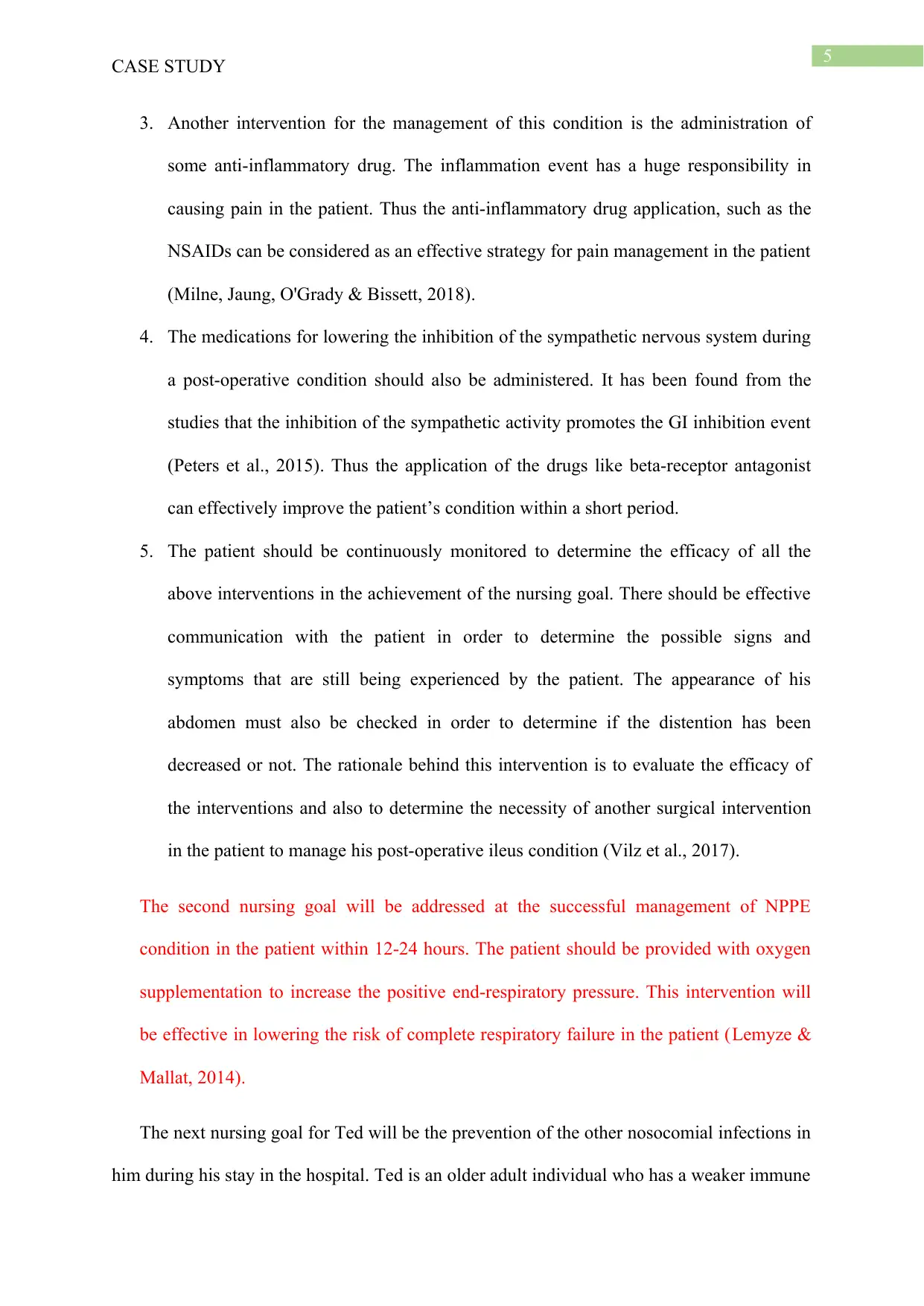
5
CASE STUDY
3. Another intervention for the management of this condition is the administration of
some anti-inflammatory drug. The inflammation event has a huge responsibility in
causing pain in the patient. Thus the anti-inflammatory drug application, such as the
NSAIDs can be considered as an effective strategy for pain management in the patient
(Milne, Jaung, O'Grady & Bissett, 2018).
4. The medications for lowering the inhibition of the sympathetic nervous system during
a post-operative condition should also be administered. It has been found from the
studies that the inhibition of the sympathetic activity promotes the GI inhibition event
(Peters et al., 2015). Thus the application of the drugs like beta-receptor antagonist
can effectively improve the patient’s condition within a short period.
5. The patient should be continuously monitored to determine the efficacy of all the
above interventions in the achievement of the nursing goal. There should be effective
communication with the patient in order to determine the possible signs and
symptoms that are still being experienced by the patient. The appearance of his
abdomen must also be checked in order to determine if the distention has been
decreased or not. The rationale behind this intervention is to evaluate the efficacy of
the interventions and also to determine the necessity of another surgical intervention
in the patient to manage his post-operative ileus condition (Vilz et al., 2017).
The second nursing goal will be addressed at the successful management of NPPE
condition in the patient within 12-24 hours. The patient should be provided with oxygen
supplementation to increase the positive end-respiratory pressure. This intervention will
be effective in lowering the risk of complete respiratory failure in the patient (Lemyze &
Mallat, 2014).
The next nursing goal for Ted will be the prevention of the other nosocomial infections in
him during his stay in the hospital. Ted is an older adult individual who has a weaker immune
CASE STUDY
3. Another intervention for the management of this condition is the administration of
some anti-inflammatory drug. The inflammation event has a huge responsibility in
causing pain in the patient. Thus the anti-inflammatory drug application, such as the
NSAIDs can be considered as an effective strategy for pain management in the patient
(Milne, Jaung, O'Grady & Bissett, 2018).
4. The medications for lowering the inhibition of the sympathetic nervous system during
a post-operative condition should also be administered. It has been found from the
studies that the inhibition of the sympathetic activity promotes the GI inhibition event
(Peters et al., 2015). Thus the application of the drugs like beta-receptor antagonist
can effectively improve the patient’s condition within a short period.
5. The patient should be continuously monitored to determine the efficacy of all the
above interventions in the achievement of the nursing goal. There should be effective
communication with the patient in order to determine the possible signs and
symptoms that are still being experienced by the patient. The appearance of his
abdomen must also be checked in order to determine if the distention has been
decreased or not. The rationale behind this intervention is to evaluate the efficacy of
the interventions and also to determine the necessity of another surgical intervention
in the patient to manage his post-operative ileus condition (Vilz et al., 2017).
The second nursing goal will be addressed at the successful management of NPPE
condition in the patient within 12-24 hours. The patient should be provided with oxygen
supplementation to increase the positive end-respiratory pressure. This intervention will
be effective in lowering the risk of complete respiratory failure in the patient (Lemyze &
Mallat, 2014).
The next nursing goal for Ted will be the prevention of the other nosocomial infections in
him during his stay in the hospital. Ted is an older adult individual who has a weaker immune
⊘ This is a preview!⊘
Do you want full access?
Subscribe today to unlock all pages.

Trusted by 1+ million students worldwide
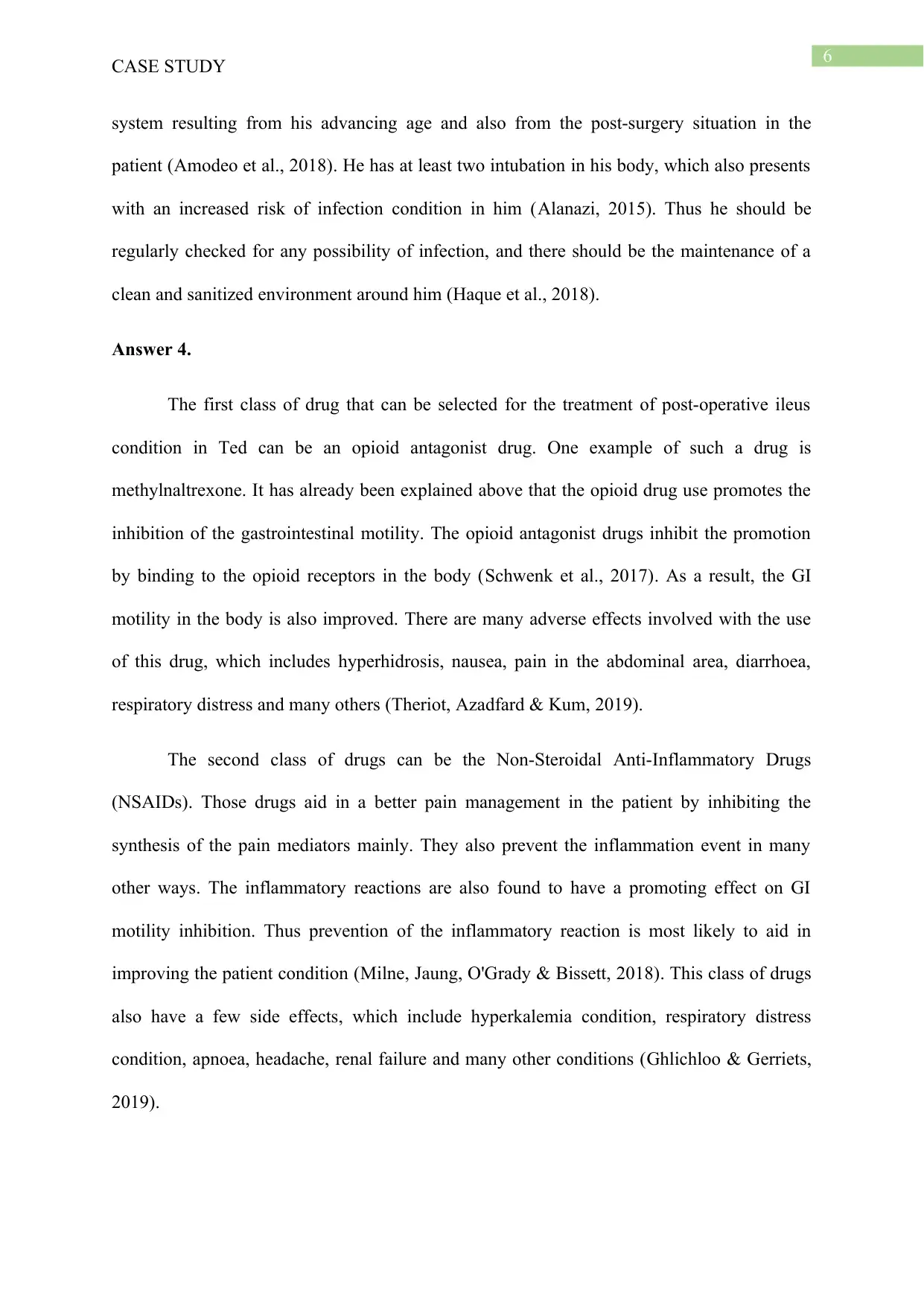
6
CASE STUDY
system resulting from his advancing age and also from the post-surgery situation in the
patient (Amodeo et al., 2018). He has at least two intubation in his body, which also presents
with an increased risk of infection condition in him (Alanazi, 2015). Thus he should be
regularly checked for any possibility of infection, and there should be the maintenance of a
clean and sanitized environment around him (Haque et al., 2018).
Answer 4.
The first class of drug that can be selected for the treatment of post-operative ileus
condition in Ted can be an opioid antagonist drug. One example of such a drug is
methylnaltrexone. It has already been explained above that the opioid drug use promotes the
inhibition of the gastrointestinal motility. The opioid antagonist drugs inhibit the promotion
by binding to the opioid receptors in the body (Schwenk et al., 2017). As a result, the GI
motility in the body is also improved. There are many adverse effects involved with the use
of this drug, which includes hyperhidrosis, nausea, pain in the abdominal area, diarrhoea,
respiratory distress and many others (Theriot, Azadfard & Kum, 2019).
The second class of drugs can be the Non-Steroidal Anti-Inflammatory Drugs
(NSAIDs). Those drugs aid in a better pain management in the patient by inhibiting the
synthesis of the pain mediators mainly. They also prevent the inflammation event in many
other ways. The inflammatory reactions are also found to have a promoting effect on GI
motility inhibition. Thus prevention of the inflammatory reaction is most likely to aid in
improving the patient condition (Milne, Jaung, O'Grady & Bissett, 2018). This class of drugs
also have a few side effects, which include hyperkalemia condition, respiratory distress
condition, apnoea, headache, renal failure and many other conditions (Ghlichloo & Gerriets,
2019).
CASE STUDY
system resulting from his advancing age and also from the post-surgery situation in the
patient (Amodeo et al., 2018). He has at least two intubation in his body, which also presents
with an increased risk of infection condition in him (Alanazi, 2015). Thus he should be
regularly checked for any possibility of infection, and there should be the maintenance of a
clean and sanitized environment around him (Haque et al., 2018).
Answer 4.
The first class of drug that can be selected for the treatment of post-operative ileus
condition in Ted can be an opioid antagonist drug. One example of such a drug is
methylnaltrexone. It has already been explained above that the opioid drug use promotes the
inhibition of the gastrointestinal motility. The opioid antagonist drugs inhibit the promotion
by binding to the opioid receptors in the body (Schwenk et al., 2017). As a result, the GI
motility in the body is also improved. There are many adverse effects involved with the use
of this drug, which includes hyperhidrosis, nausea, pain in the abdominal area, diarrhoea,
respiratory distress and many others (Theriot, Azadfard & Kum, 2019).
The second class of drugs can be the Non-Steroidal Anti-Inflammatory Drugs
(NSAIDs). Those drugs aid in a better pain management in the patient by inhibiting the
synthesis of the pain mediators mainly. They also prevent the inflammation event in many
other ways. The inflammatory reactions are also found to have a promoting effect on GI
motility inhibition. Thus prevention of the inflammatory reaction is most likely to aid in
improving the patient condition (Milne, Jaung, O'Grady & Bissett, 2018). This class of drugs
also have a few side effects, which include hyperkalemia condition, respiratory distress
condition, apnoea, headache, renal failure and many other conditions (Ghlichloo & Gerriets,
2019).
Paraphrase This Document
Need a fresh take? Get an instant paraphrase of this document with our AI Paraphraser
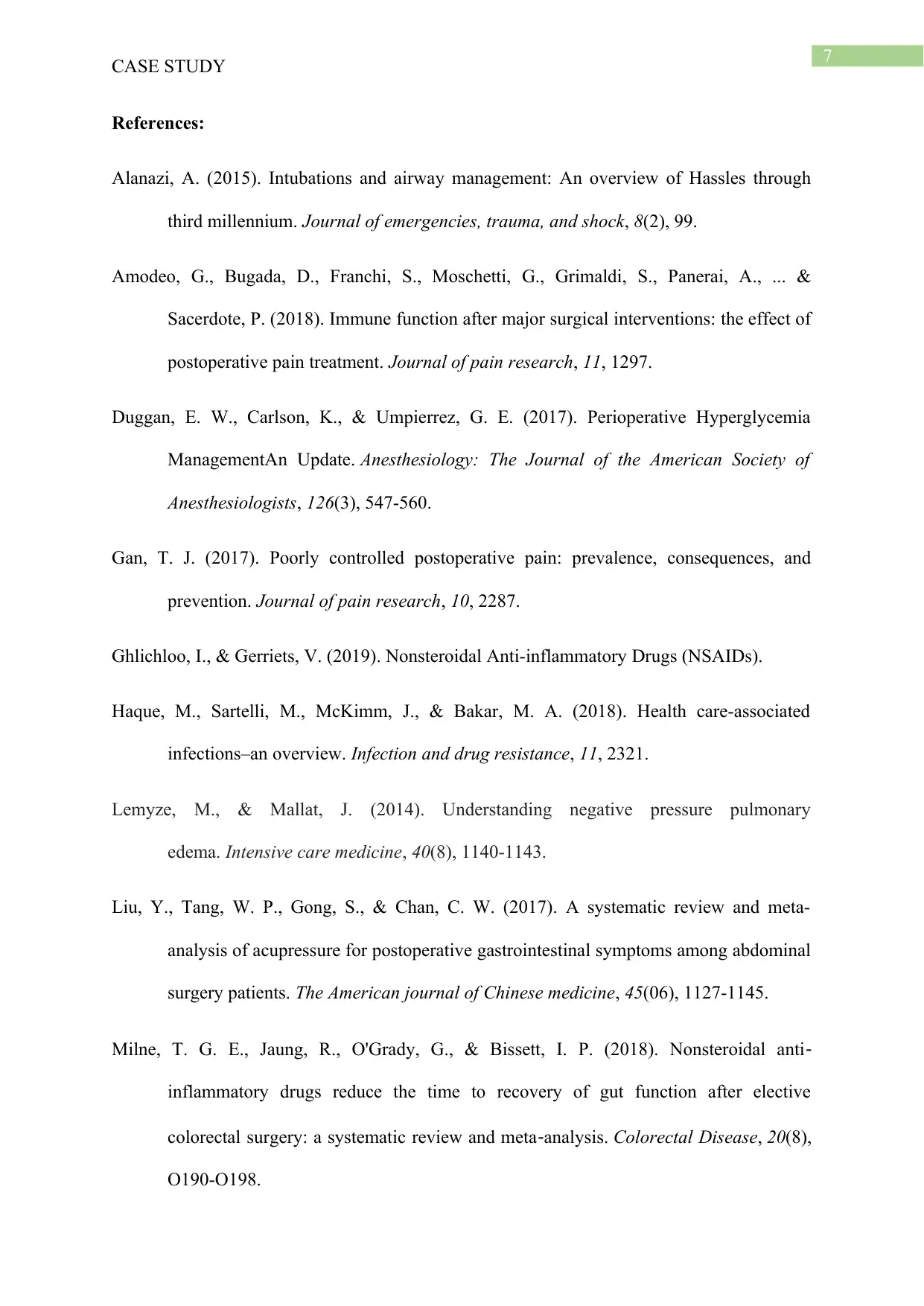
7
CASE STUDY
References:
Alanazi, A. (2015). Intubations and airway management: An overview of Hassles through
third millennium. Journal of emergencies, trauma, and shock, 8(2), 99.
Amodeo, G., Bugada, D., Franchi, S., Moschetti, G., Grimaldi, S., Panerai, A., ... &
Sacerdote, P. (2018). Immune function after major surgical interventions: the effect of
postoperative pain treatment. Journal of pain research, 11, 1297.
Duggan, E. W., Carlson, K., & Umpierrez, G. E. (2017). Perioperative Hyperglycemia
ManagementAn Update. Anesthesiology: The Journal of the American Society of
Anesthesiologists, 126(3), 547-560.
Gan, T. J. (2017). Poorly controlled postoperative pain: prevalence, consequences, and
prevention. Journal of pain research, 10, 2287.
Ghlichloo, I., & Gerriets, V. (2019). Nonsteroidal Anti-inflammatory Drugs (NSAIDs).
Haque, M., Sartelli, M., McKimm, J., & Bakar, M. A. (2018). Health care-associated
infections–an overview. Infection and drug resistance, 11, 2321.
Lemyze, M., & Mallat, J. (2014). Understanding negative pressure pulmonary
edema. Intensive care medicine, 40(8), 1140-1143.
Liu, Y., Tang, W. P., Gong, S., & Chan, C. W. (2017). A systematic review and meta-
analysis of acupressure for postoperative gastrointestinal symptoms among abdominal
surgery patients. The American journal of Chinese medicine, 45(06), 1127-1145.
Milne, T. G. E., Jaung, R., O'Grady, G., & Bissett, I. P. (2018). Nonsteroidal anti‐
inflammatory drugs reduce the time to recovery of gut function after elective
colorectal surgery: a systematic review and meta‐analysis. Colorectal Disease, 20(8),
O190-O198.
CASE STUDY
References:
Alanazi, A. (2015). Intubations and airway management: An overview of Hassles through
third millennium. Journal of emergencies, trauma, and shock, 8(2), 99.
Amodeo, G., Bugada, D., Franchi, S., Moschetti, G., Grimaldi, S., Panerai, A., ... &
Sacerdote, P. (2018). Immune function after major surgical interventions: the effect of
postoperative pain treatment. Journal of pain research, 11, 1297.
Duggan, E. W., Carlson, K., & Umpierrez, G. E. (2017). Perioperative Hyperglycemia
ManagementAn Update. Anesthesiology: The Journal of the American Society of
Anesthesiologists, 126(3), 547-560.
Gan, T. J. (2017). Poorly controlled postoperative pain: prevalence, consequences, and
prevention. Journal of pain research, 10, 2287.
Ghlichloo, I., & Gerriets, V. (2019). Nonsteroidal Anti-inflammatory Drugs (NSAIDs).
Haque, M., Sartelli, M., McKimm, J., & Bakar, M. A. (2018). Health care-associated
infections–an overview. Infection and drug resistance, 11, 2321.
Lemyze, M., & Mallat, J. (2014). Understanding negative pressure pulmonary
edema. Intensive care medicine, 40(8), 1140-1143.
Liu, Y., Tang, W. P., Gong, S., & Chan, C. W. (2017). A systematic review and meta-
analysis of acupressure for postoperative gastrointestinal symptoms among abdominal
surgery patients. The American journal of Chinese medicine, 45(06), 1127-1145.
Milne, T. G. E., Jaung, R., O'Grady, G., & Bissett, I. P. (2018). Nonsteroidal anti‐
inflammatory drugs reduce the time to recovery of gut function after elective
colorectal surgery: a systematic review and meta‐analysis. Colorectal Disease, 20(8),
O190-O198.
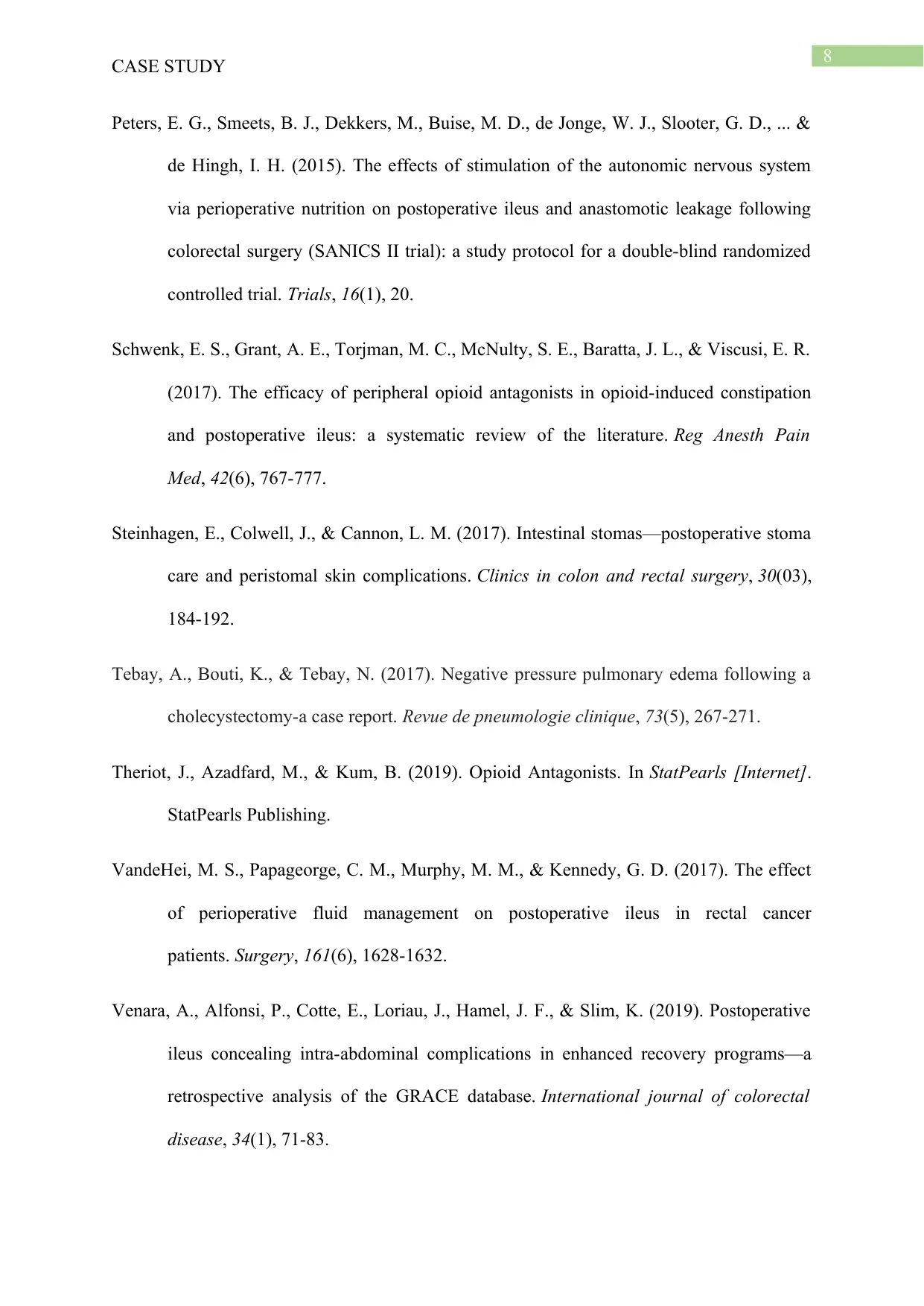
8
CASE STUDY
Peters, E. G., Smeets, B. J., Dekkers, M., Buise, M. D., de Jonge, W. J., Slooter, G. D., ... &
de Hingh, I. H. (2015). The effects of stimulation of the autonomic nervous system
via perioperative nutrition on postoperative ileus and anastomotic leakage following
colorectal surgery (SANICS II trial): a study protocol for a double-blind randomized
controlled trial. Trials, 16(1), 20.
Schwenk, E. S., Grant, A. E., Torjman, M. C., McNulty, S. E., Baratta, J. L., & Viscusi, E. R.
(2017). The efficacy of peripheral opioid antagonists in opioid-induced constipation
and postoperative ileus: a systematic review of the literature. Reg Anesth Pain
Med, 42(6), 767-777.
Steinhagen, E., Colwell, J., & Cannon, L. M. (2017). Intestinal stomas—postoperative stoma
care and peristomal skin complications. Clinics in colon and rectal surgery, 30(03),
184-192.
Tebay, A., Bouti, K., & Tebay, N. (2017). Negative pressure pulmonary edema following a
cholecystectomy-a case report. Revue de pneumologie clinique, 73(5), 267-271.
Theriot, J., Azadfard, M., & Kum, B. (2019). Opioid Antagonists. In StatPearls [Internet].
StatPearls Publishing.
VandeHei, M. S., Papageorge, C. M., Murphy, M. M., & Kennedy, G. D. (2017). The effect
of perioperative fluid management on postoperative ileus in rectal cancer
patients. Surgery, 161(6), 1628-1632.
Venara, A., Alfonsi, P., Cotte, E., Loriau, J., Hamel, J. F., & Slim, K. (2019). Postoperative
ileus concealing intra-abdominal complications in enhanced recovery programs—a
retrospective analysis of the GRACE database. International journal of colorectal
disease, 34(1), 71-83.
CASE STUDY
Peters, E. G., Smeets, B. J., Dekkers, M., Buise, M. D., de Jonge, W. J., Slooter, G. D., ... &
de Hingh, I. H. (2015). The effects of stimulation of the autonomic nervous system
via perioperative nutrition on postoperative ileus and anastomotic leakage following
colorectal surgery (SANICS II trial): a study protocol for a double-blind randomized
controlled trial. Trials, 16(1), 20.
Schwenk, E. S., Grant, A. E., Torjman, M. C., McNulty, S. E., Baratta, J. L., & Viscusi, E. R.
(2017). The efficacy of peripheral opioid antagonists in opioid-induced constipation
and postoperative ileus: a systematic review of the literature. Reg Anesth Pain
Med, 42(6), 767-777.
Steinhagen, E., Colwell, J., & Cannon, L. M. (2017). Intestinal stomas—postoperative stoma
care and peristomal skin complications. Clinics in colon and rectal surgery, 30(03),
184-192.
Tebay, A., Bouti, K., & Tebay, N. (2017). Negative pressure pulmonary edema following a
cholecystectomy-a case report. Revue de pneumologie clinique, 73(5), 267-271.
Theriot, J., Azadfard, M., & Kum, B. (2019). Opioid Antagonists. In StatPearls [Internet].
StatPearls Publishing.
VandeHei, M. S., Papageorge, C. M., Murphy, M. M., & Kennedy, G. D. (2017). The effect
of perioperative fluid management on postoperative ileus in rectal cancer
patients. Surgery, 161(6), 1628-1632.
Venara, A., Alfonsi, P., Cotte, E., Loriau, J., Hamel, J. F., & Slim, K. (2019). Postoperative
ileus concealing intra-abdominal complications in enhanced recovery programs—a
retrospective analysis of the GRACE database. International journal of colorectal
disease, 34(1), 71-83.
⊘ This is a preview!⊘
Do you want full access?
Subscribe today to unlock all pages.

Trusted by 1+ million students worldwide
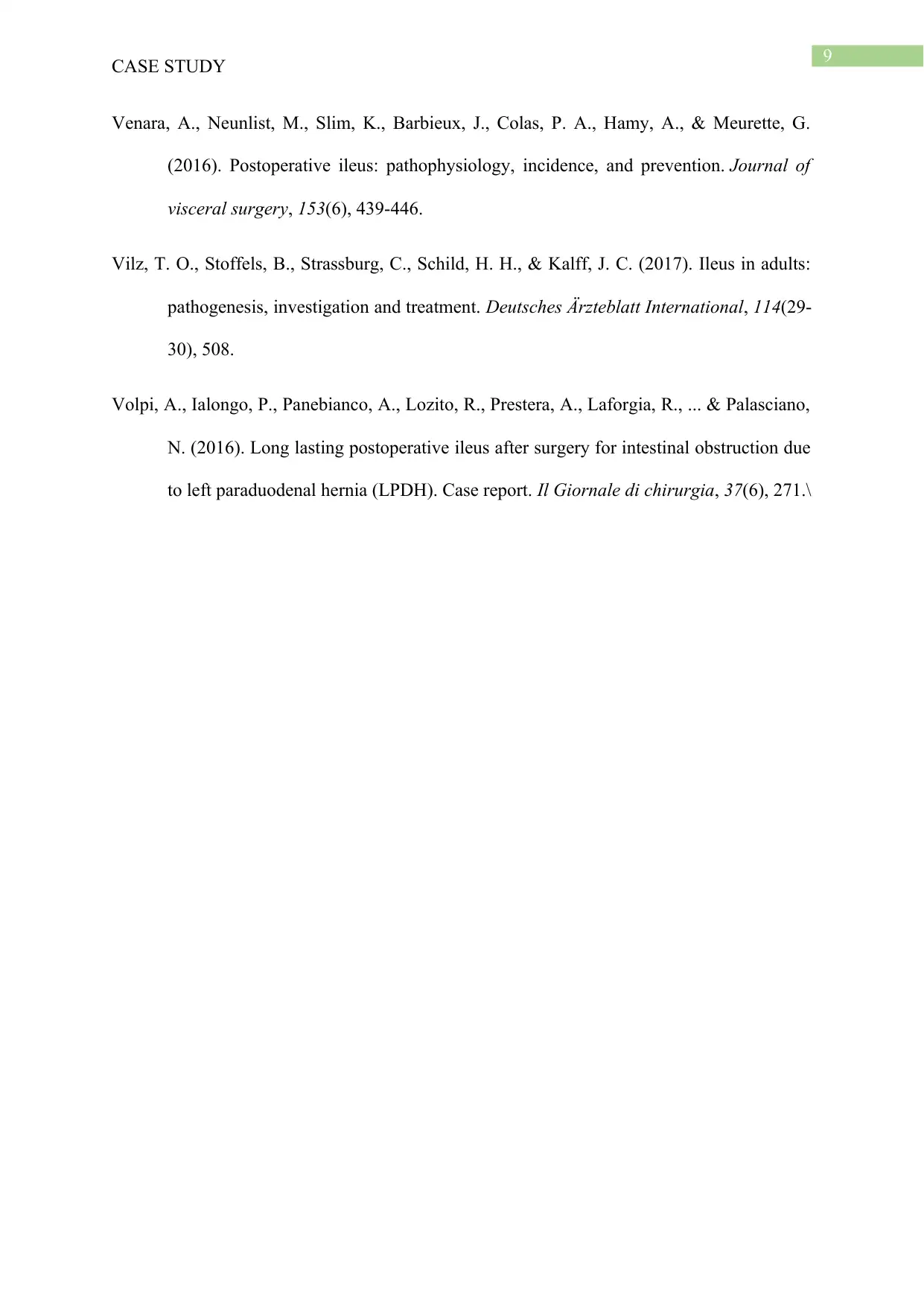
9
CASE STUDY
Venara, A., Neunlist, M., Slim, K., Barbieux, J., Colas, P. A., Hamy, A., & Meurette, G.
(2016). Postoperative ileus: pathophysiology, incidence, and prevention. Journal of
visceral surgery, 153(6), 439-446.
Vilz, T. O., Stoffels, B., Strassburg, C., Schild, H. H., & Kalff, J. C. (2017). Ileus in adults:
pathogenesis, investigation and treatment. Deutsches Ärzteblatt International, 114(29-
30), 508.
Volpi, A., Ialongo, P., Panebianco, A., Lozito, R., Prestera, A., Laforgia, R., ... & Palasciano,
N. (2016). Long lasting postoperative ileus after surgery for intestinal obstruction due
to left paraduodenal hernia (LPDH). Case report. Il Giornale di chirurgia, 37(6), 271.\
CASE STUDY
Venara, A., Neunlist, M., Slim, K., Barbieux, J., Colas, P. A., Hamy, A., & Meurette, G.
(2016). Postoperative ileus: pathophysiology, incidence, and prevention. Journal of
visceral surgery, 153(6), 439-446.
Vilz, T. O., Stoffels, B., Strassburg, C., Schild, H. H., & Kalff, J. C. (2017). Ileus in adults:
pathogenesis, investigation and treatment. Deutsches Ärzteblatt International, 114(29-
30), 508.
Volpi, A., Ialongo, P., Panebianco, A., Lozito, R., Prestera, A., Laforgia, R., ... & Palasciano,
N. (2016). Long lasting postoperative ileus after surgery for intestinal obstruction due
to left paraduodenal hernia (LPDH). Case report. Il Giornale di chirurgia, 37(6), 271.\
1 out of 10
Related Documents
Your All-in-One AI-Powered Toolkit for Academic Success.
+13062052269
info@desklib.com
Available 24*7 on WhatsApp / Email
![[object Object]](/_next/static/media/star-bottom.7253800d.svg)
Unlock your academic potential
Copyright © 2020–2025 A2Z Services. All Rights Reserved. Developed and managed by ZUCOL.





